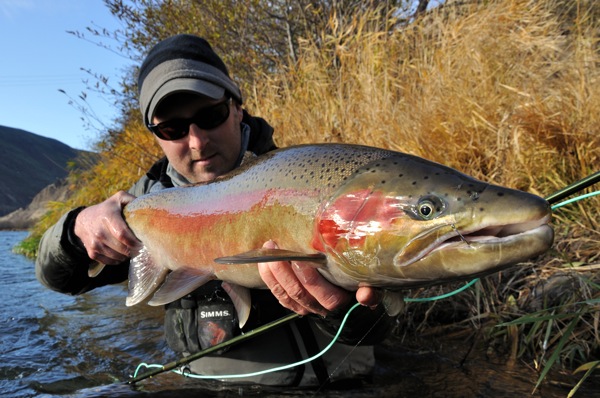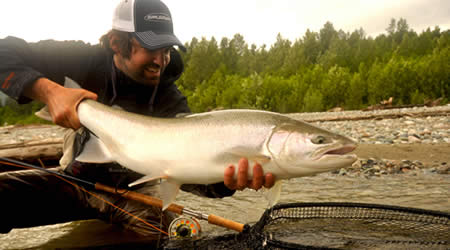

Winter Steelhead (Dec-April) Early-Run Summer Steelhead (May-June)
The Clackamas River begins as a high alpine stream in the Northern Oregon Cascade Mountains before it descends over eighty miles to the west where it eventually meets the tidally influenced Willamette River in Oregon City. Known locally as the Clack, it drains the forests, springs and snow-melt of the western Cascadian ridgeline between Mt Hood and Mt Jefferson. The source of its most northern fork is less than ten miles from the house I grew up in. This cold, clear, nutrient-rich water is perfect habitat for many fish species, both resident and anadromous. For me, the waters of the Clack run deep into my memory and heritage. It is where I caught many of my first small-stream trout on dry flies, and also where I was first introduced to wild winter steelhead, and I now live only ten steps from a great piece of swinging water.
The Clack’s water from the mouth upstream to River Mill Dam near Estacada is where all of its anadromous fishing takes place. This section of river provides an abundance of awesome year-round opportunity for a steelheader. Its waters beg for flies swung on two-handed rods and chrome fish are there twelve months out of the year to intercept those flies and stretch your backing. For a fly swinging junkie like me, I feel unbelievably lucky to have such an amazing river right in my backyard.
Fishing the lower Clack, we wade in the green water and swing our flies through the river’s countless ledgy slots, boulder strewn runs and broad tailouts. I prefer to use my 20ft jet boat to get from spot to spot, it is key for success. The jet boat gives me maximum flexibility to adjust and adapt to the changing conditions and the ability to stay in the fish and not waste time floating between spots. The Clack’s bounty is no secret. Don’t expect to be the only boat on the water. Though, with the flexibility of the jet boat you can usually find solitude and be at the right spot at the right time to connect with the river’s awesome ocean bright fish.
The fact that there are others on the water factors into my fishing techniques. First thing in the morning with good water conditions I may fish a bigger fly on a light sink tip over a broad tail out to rested fish. When I pull into another run later in the day, I assume that I am not the first person to fish that spot and switch to a smaller fly with a larger sink-tip and concentrate my efforts on the deepest slot of the run.
Taking into consideration all of the factors on the river greatly increases the odds offinding fishon a swung fly. Luckily for us, Clack fish are very aggressive to the fly, and if your efforts are concentrated in the right places, you are often rewarded.
I would love to take you out for a day or two on my home water to show you some of the tricks I have learned and give the river a chance to reveal some of its secrets to you. The rewards can be immense and unforgettable. Though you can catch steelhead on the Clack every month of the year, my favorite time is December through June. Winter is the season the river is known for, but one secret that is not often known is May and June can also be incredibly productive.
Oops... We must have sold out.
No products have been assigned to this category.
Back